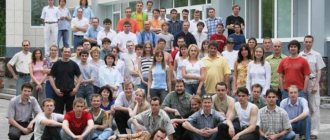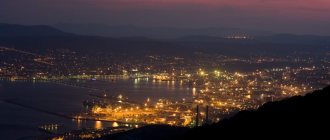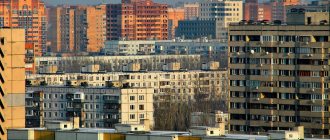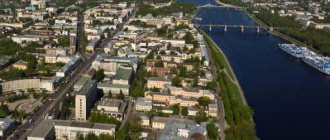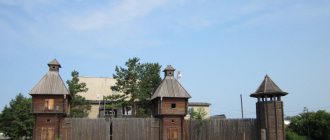How many people live in the city of Magnitogorsk? What is the population as of January 1, 2022?
Statistics have always interested people and no matter what it concerns, and we are interested in it for a variety of reasons, out of curiosity and for other, very different reasons, we want to know about something, for example, about a given topic, which we will deal with below.
Where is Magnitogorsk located?
If you have never been to those parts, it may be difficult to find Magnitogorsk on a map of Russia.
Hint - look for Kazakhstan (southeast Russia) and the area just above its borders - this is the Southern Urals. It is there, in the Chelyabinsk region, that Magnitogorsk is located.
I mentally draw lines on the map between the cities of Chelyabinsk, Ufa and Orenburg (Orsk is possible) and along the center of the hypotenuse (the longest side of the triangle) and there will be Magnitogorsk.
Distance to major cities from Magnitogorsk:
- Moscow – 1688 km;
- Chelyabinsk – 303 km;
- Miass – 249 km;
- Ufa – 344 km;
- Ekaterinburg – 510 km;
- Beloretsk – 92 km.
Huge distances that can be covered by plane (flights to Moscow, Orenburg, Mineralnye Vody and Antalya) or by rail. Residents of Magnitogorsk use buses (flights to Yekaterinburg, Chelyabinsk, Miass, Chebarkul) or personal vehicles for everyday needs.
Magnitogorsk is located at the intersection of highways 75K-004 from Chelyabinsk (and then M5 to Moscow) and P316 from Ufa through Beloretsk (where the airport is located).
Magnitogorsk map
A map of Magnitogorsk will tell you the following. The area of the city is almost 400 km, the length is 27 km to the south and 22 to the west.
Magnitogorsk is lucky to be located in Europe and Asia; the Ural River is a natural border between the two parts of the world. The city is located at the foot of Magnitnaya Mountain, divided into two parts by the Ural River, and is geographically represented by three districts - Leninsky, Pravoberezhny and Ordzhonikidze.
The Magnitogorsk agglomeration is distinguished, which, in addition to the city, includes five nearby districts.
Population in municipal, urban areas
It emerged in 1929 as a settlement during the construction of a metallurgical plant near Mount Magnitnaya, near the Cossack village of Magnitnaya, founded in the 18th century.
Located at the foot of Magnitnaya Mountain, on the eastern slope of the Southern Urals, on both banks of the Ural River. The right bank is located in Europe, the left bank is in Asia, according to the current border line of parts of the world.
One of six cities in the world located in two parts of the world (Europe and Asia).
The climate of Magnitogorsk has a pronounced continental character, characteristic of the entire Southern Trans-Urals, with cold winters with little snow and dry, warm summers.
Now we will tell those interested in the climate in the city of Magnitogorsk, what the average temperature was according to research over the past few years, the maximum and minimum values, as well as the average and norms of precipitation:
Climate of Magnitogorsk (weather, precipitation)
| Index | Jan. | Feb. | March | Apr. | May | June | July | Aug. | Sep. | Oct. | Nov. | Dec. | Year |
| Abs. Max. | 3 | 5,6 | 16,5 | 30,1 | 33,9 | 38,5 | 38,9 | 37,2 | 35,1 | 24,3 | 15,8 | 8,2 | 38,9 |
| Avg. Max. | −10 | −8,8 | −2,1 | 10,6 | 19,4 | 24,9 | 25,2 | 23,4 | 17,4 | 9,1 | −1,9 | −7,9 | 8,3 |
| Avg. pace. | −14,1 | −13,5 | −7,1 | 4,5 | 12,6 | 18,2 | 19,2 | 17 | 11,1 | 3,8 | −5,9 | −11,9 | 2,8 |
| Avg. min. | −18,3 | −18,1 | −12 | −1 | 5,9 | 11,4 | 13,4 | 11,1 | 5,3 | −0,8 | −9,6 | −15,9 | −2,4 |
| Abs. min. | −42,8 | −46,1 | −36,1 | −23,9 | −8,9 | −2,8 | 3,9 | 0 | −11,1 | −21 | −36,1 | −38,9 | −46,1 |
| Norm of siege. | 19 | 14 | 18 | 27 | 33 | 39 | 60 | 48 | 27 | 24 | 23 | 21 | 353 |
Whether the population of the city of Magnitogorsk is decreasing or increasing, what is its official number according to the census as of January 1, 2022, in its municipalities, urban areas, we will learn about this later, when accurate information appears, for now we will present the currently available figures.
Founding date of Magnitogorsk: 1929
Time zone: MSK +2, UTS +5
Population of Magnitogorsk
The number of residents in Magnitogorsk directly depends on two factors - industrial development (availability of work, salary level) and living conditions (ecology, climate).
Unfortunately, in recent years the population of Magnitogorsk has been decreasing. I think this is due to the stages of development of the city. For example, in 1989 there was a sharp jump in the growth of the number of residents due to labor migration, but now these people have retired and many are leaving the harsh region. Or there is some kind of internal logic of the city that is not related to jobs and birth rates, but is invisible to an outsider.
I will give several dates when there were sharp fluctuations in the city's population.
| Year | Number of people, thousand people |
| 1931 | 64 100 |
| 1939 | 146 000 |
| 1962 | 333 000 |
| 1991 | 444 000 |
| 2000 | 427 900 |
| 2010 | 407 774 |
| 2017 | 418 241 |
| 2019 | 413 267 |
Now the number of residents is 416,521; if we take into account the agglomeration, then there are more than 633 thousand of them.
What is the population of the city of Magnitogorsk?
National composition
According to the 2010 All-Russian Census:
| People | Number of people | % of indicated national |
| Russians | 338 595 | 84,74 % |
| Tatars | 20 433 | 5,22 % |
| Bashkirs | 15 172 | 3,88 % |
| Ukrainians | 6101 | 1,56 % |
| Kazakhs | 4130 | 1,05 % |
| Tajiks | 1993 | 0,51 % |
| Belarusians | 1473 | 0,38 % |
| Armenians | 1216 | 0,31 % |
| Chuvash | 1210 | 0,31 % |
| Azerbaijanis | 1024 | 0,26 % |
| other nationalities | 6967 | 1,78 % |
| of all those who indicated their nationality | 391 314 | 100,00 |
| the entire population of the city. Magnitogorsk district | 407 775 |
With the population of the city of Magnitogorsk as of January 1, 2022, how many people live in this territory, people in municipalities and this locality, this territorial unit of the Russian Federation, that’s what we figured out here, we made our contribution to satisfying the requests of those interested in this statistical information .
Unfavorable days in 2022, difficult for health and well-being
Lunar calendar for hair cutting 2022, favorable days to cut hair
Sights of Magnitogorsk
The sights of Magnitogorsk are mainly bronze or granite monuments in honor of outstanding people of the region - engineers, scientists, workers. They are not very interesting to tourists, since they do not carry much cultural and aesthetic value.
But I would note the unique nature of the Southern Urals, sights of miraculous origin and several archaeological sites.
In the place where the city of Magnitogorsk is located, you can see:
- Arkaim, the mystery of which has not yet been solved and excites the minds of lovers of the unknown and inexplicable by science;
- Iremel is a mountain on the slope of which there is a national park;
- Verkhneuralsk is a city that immerses you in the atmosphere of merchants and Cossack life.
There are also many protected and recreational areas in the surrounding area.
History of Magnitogorsk
Magnitogorsk is a fairly young city, it is not yet 100 years old, although the lands were developed back in the 17th century. The history of Magnitogorsk begins in the 20s of the 20th century, when the development of the riches of Magnitogorsk began, factories and a railway line began to be built to export ore and metal for the needs of the country. Magnitogorsk was designated as a city in 1929.
Magnitogorsk grew and developed rapidly; during the Second World War, many important factories and production facilities were evacuated here. Then, in peacetime, the time came for the improvement of the city - gas was installed in the houses, trams were launched. To this day, Magnitogorsk is an important and significant city in the Russian Federation, a flagship of ferrous metallurgy and heavy industry.
Magnitogorsk
History of Magnitogorsk
The generous depths of the Magnetic Mountain, rising above the Yaik River (Ural), have been developed by local ore miners since time immemorial.
Tatar and Bashkir craftsmen mined ore here, smelted high-quality iron and excellent weapon steel from it. The Bashkirs called the mountain itself “Atach”. The first Russian settlement that pushed the Bashkir uluses away from Magnitnaya Mountain was a fortified village built by an advance detachment of Cossacks in 1743. It continued the Orenburg chain of forts of the Russian Empire, which was actively expanding its eastern borders. Next lay a vast plain; on Russian maps of that time it was designated as the Kyrgyz-Kaysat steppe. The village of Magnitnaya is connected with the uprising of Emelyan Pugachev in blood - during its assault in 1774, thousands of rebels and defenders were killed, and Pugachev himself was wounded by shrapnel from the fortress cannons. However, the ataman took the fortress and gathered an army of 10,000 sabers. The basis of this army were Yaik Cossacks, Bashkir and Tatar horsemen. After the suppression of the Pugachev rebellion in 1775, the angry Empress Catherine II ordered the Bashkir toponym “Yaik” to be erased from the maps and henceforth to call the river the Ural, in order to forever eradicate the memory of the Yaik Cossack freemen.
In subsequent years, Russian entrepreneurs started developing mines here. The ore was transported to an iron smelter built 85 km northwest of the settlement (today the Beloretsk Metallurgical Plant). The ordinary Ural mining village was not distinguished by anything remarkable. The most striking events in its history were the visits of crowned heads: in 1837, Tsarevich Alexander Nikolaevich visited here while passing through, and in 1891, the train of Emperor Nicholas II stopped here.
Everything changed in 1929, when, according to the plan for the first five-year industrialization of the USSR, it was decided to build a huge plant right at the source of iron ore, which became the flagship of the Soviet metallurgical industry and was popularly called “Magnitka”. Thousands of builders headed to Magnetic Mountain. The first streets of the future city of Magnitogorsk were surrounded by rows of tarpaulin tents of pioneers, but at the same time as the factory floors, the walls of good-quality residential buildings also grew.
Soviet engineers had no experience of such large-scale construction. The construction of the metallurgical complex was advised by specialists from the United States, and to design the city, the Soviet government invited a group of German architects under the leadership of the famous innovative urban planner Ernst May. According to his designs, the first residential quarter of Magnitogorsk was built with all the necessary infrastructure - kindergartens and nurseries, schools, shops. This microdistrict, exemplary for those times, called “Sotsgorod”, still exists.
At first, the construction of the city took place on the left bank of the Ural River, where most of Magnitogorsk’s industrial enterprises were built. At the end of the 40s, residential neighborhoods appeared on the right bank. Here you can see classic examples of good-quality buildings in the Stalinist Empire style, their facades are decorated with turrets, columns, arches, and niches. There are especially many such pompous buildings on Leningradskaya Street. However, the bulk of urban buildings in the first decades were low-rise and featureless. Only in the 80s, for the half-century anniversary of Magnitogorsk, interesting architectural highlights and 16-story high-rise buildings began to be erected on its streets.
During the Great Patriotic War, every third artillery shell fired at the Nazis was machined from Magnitogorsk steel, half of the Soviet tanks were built from armor plates produced at Magnitogorsk. Monuments erected in city squares remind of this contribution to the defeat of the occupiers. In 2015, Magnitogorsk was awarded the honorary title of “City of Labor Valor and Glory.”
Geography and climate
Magnitogorsk is one of the few cities located in two parts of the world. The blocks built on the right bank of the Ural River are geographically located in Europe, the left bank faces the east, and here is Asia. The city's territory is 392 km², its development stretches along the river for 27 kilometers. In 2022, the population of Magnitogorsk exceeded 416 thousand inhabitants. The western suburbs border on the territory of neighboring Bashkiria, and Magnitogorsk airport is located on the territory of this republic.
In 1937, to supply the metallurgical complex with water, a dam was built in Magnitogorsk, blocking the Urals. A reservoir was formed, stretching from south to north for 24 km. A significant part of the reservoir is located within the boundaries of Magnitogorsk; the townspeople call it the Factory Pond. The left-bank and right-bank areas are connected by the Northern, Central and Southern bridge crossings, and the Cossack crossing runs along the fourth dam.
Magnitogorsk is located in the continental climate zone. Winters here are cold and with little snow, summers are warm and often dry. In January, the air temperature usually drops to -18...-14 °C, but sometimes Siberian anticyclones bring severe frosts. The record figure in February 1975 was –46.1 °C. Spring comes to the city in April, when the air warms up to +5...+10 °C. This time of year is also marked by anomalies. For example, in May 2019, residents of Magnitogorsk were surprised by the extraordinary heat; the thermometer reached +28.8 °C; such a temperature is rarely recorded here even in August.
The swimming season on city beaches opens in June, when the water warms up to +18...+20 °C, and lasts until the beginning of September. The most comfortable water temperature is in July-August: +22…+24 °C.
Sights of Magnitogorsk
The streets of Magnitogorsk are decorated with monuments to the first builders of Magnitogorsk, a modern metallurgist and a master of Demidov’s times. In the park near Metallurgov Avenue, an elderly couple sat on a cast-iron bench; this monument, beloved by the townspeople, is dedicated to their parents. In Lomonosov Park there is a sculpture depicting a teacher leading a young student along symbolic steps to knowledge. There are funny statues of a plumber and a janitor in the city; tourists love to take pictures with these bronze characters.
The outlines of the monument called “The First Tent”, which has stood since 1966 at the entrance to the Magnitogorsk Veterans Park, are extremely laconic and emotionally expressive. The composition is included in the register of monuments of federal significance. The steam locomotive frozen on a concrete pedestal near the railway station also reminds us of the pioneers. This is the first locomotive to deliver a train carrying construction workers here in 1929. On his coal tender there is a perky slogan: “Give Magnitostroy!”
A recognizable symbol of Magnitogorsk has become a monument known throughout the country, called “Rear to Front”. The monument was erected on a mound in the city Victory Park in 1979. The 15-meter bronze sculptures of the composition depict a metallurgist handing over a symbolic sword to a soldier. At the foot of the monument lies a star carved from a single block of red granite, with the Eternal Flame burning in its center.
On the People's Festival Square, opposite the city administration building, rises a 29-meter marble tower, topped with the main clock of Magnitogorsk. Four concave “plates” of black dials with a diameter of 3.5 m are facing the cardinal directions, the time is indicated by gilded hands, each hour is marked by the melodic chiming of chimes. At the base of the pylon with a clock there is a light and music fountain. In the evenings, the chimes and fountain are beautifully illuminated. This is the most popular meeting place among city residents.
Another light and music fountain is located at the entrance to the Palace of Culture of Metallurgists on Naberezhnaya Street, 1. The three-tier waterfall is crowned with tubular nozzles that create a sparkling water ball from thin jets. Residents of Magnitogorsk nicknamed him “Dandelion”. The dance of the jets is accompanied by music and lighting. In the park opposite there is a monument to Sergo Ordzhonikidze, and the cultural center, built in the late 30s of the last century, has since then been named after the first People's Commissar of Heavy Industry of the USSR.
In the 131st microdistrict on the right bank of the Urals, a sundial was installed in 1983 (Galiullina St., 17). Tall snow-white pylons with clocks are surrounded by smiling lions. This beautiful sculptural composition represents a chronological mystery: not only tourists, but also local residents do not know how to use it to determine the current time.
There is an art gallery on Gazeta Pravda Street, 12/1. Art Saturdays are held here weekly. The two-hour program includes an excursion, a lecture by an art historian and master classes, where participants master the origami technique and enthusiastically create flower arrangements and beadwork. Here you can get acquainted with other types of artistic creativity. It is offered to join the project for 250 rubles. The gallery is open daily except Sunday. Opening hours: 11:00-18:30. After viewing the exhibition, stop by the “Bitter Coffee” coffee shop; a popular establishment is located two steps away. Get to the gallery by bus No. 17 or minibus No. 31, you need to go to the Drama Theater stop. Trams No. 1, 11, 17, 24, 29 also pass here; get off at the Kuranty stop.
The city museum of local lore is located on Sovetskaya Armiya Street, 51-A. More than 100 thousand objects and documents are presented in museum exhibitions. The oldest artifacts date back to the Bronze Age; this is a structured collection of finds from archaeologists at excavations of nearby ancient settlements. The central place in the museum is occupied by an exhibition telling the story of the founding of the village of Magnitnaya in the mid-18th century, and the role of Magnitka in supplying the Red Army with armored combat vehicles and weapons during the Great Patriotic War. Separate rooms are dedicated to the Ural minerals, flora and fauna of the region. A collection of antique samovars and samples of the work of local masters of artistic metal casting are also presented. The entrance ticket costs 50 rubles; for the right to photograph the exhibits you need to pay an additional 150 rubles. The services of a guide will cost 350 rubles. The museum is open from Monday to Friday from 10:00 to 18:00, on Saturdays the exhibition closes at 16:00, and on Sunday there is a day off. You will be taken to the museum by buses No. 21 and 24, trams No. 11, 16, 18, 22.
The seven-domed Cathedral of the Ascension of the Lord, built on the river bank, was consecrated in 2005. The gilded cross mounted on the central dome shines at a height of 52 meters. Icon painters from the Trinity-Sergius Lavra took part in painting the interiors. The cathedral became one of the largest centers of Orthodoxy in the Southern Urals. The temple complex, which occupies more than three hectares, houses various charitable services: a charity house with a refectory, a shelter for the needy, a hotel, a Sunday school, and a medical center. Several more Orthodox churches have been built in the city: the temple in the name of St. Nicholas the Wonderworker (79 Chkalova St.), the Church of Michael the Archangel (79 Kommunarov St.), the chapel of the icon of the Mother of God “Joy of All Who Sorrow” (104-B Kirova St. ). The chapel is dedicated to the memory of the repressed builders and metallurgists of Magnitka, sent to the Gulag camps. On its walls there are memorial plaques with the names of hundreds of innocent people who died. The chapel is located on the outskirts of the city, near the Left Bank cemetery. Minibus number 100 goes there from the station.
There are many Muslims among the residents of Magnitogorsk. In 2004, at the intersection of Mardzhani and Gryaznov streets, an elegant Cathedral Mosque was built at the expense of the community. The two tiers of the building are united by arched portals; the façade of the minaret is decorated with figured stonework with geometric patterns. The mosque has a madrasah, a hotel for pilgrims, and a Muslim library. On the opposite bank of the Urals there is another mosque, called “Levoberezhnaya” (Kuzbasskaya St., 1).
Photos of the city from the top point can be taken at the observation deck located on Mount Kara-Dyr. Another viewing platform is located on the outskirts of Magnitnaya Mountain, where in 1971 a simple monument was erected, created by workers for the 40th anniversary of the mine: an excavator bucket with a block of ore on a pedestal welded from steel sheets. A pedestrian path leads to this panoramic platform, starting on Shchorsa Street.
Country excursions
In the vicinity of the city there are many attractions worthy of the attention of travelers. Tourists can travel from Magnitogorsk, for example, to Paris. The village, named after the French capital, is located 95 km northeast of the city, in the Nagaybak region. On the road map of this region you will find several more French and German names. This is how the Ural Cossacks named their villages back in the 19th century - in memory of their participation in the victorious campaign of Russian troops that defeated Napoleon’s army.
To the village of Paris you need to go along the Magnitogorsk - Chelyabinsk highway until the turn sign for Ferchampenoise. On the outskirts of the village, along the banks of the Kyzyl-Chilik River, there grows a protected alder grove, recognized as a natural monument. The path will lead travelers to a spring with tasty water. But the main attraction of Paris is a copy of the Eiffel Tower 50 meters high. It was built by creative specialists in 2005; the tower serves as a cell phone tower. It did not cost much more than a standard design, and made the village famous throughout the area.
After taking a selfie at the Eiffel Tower, drive to the village of Ferchampenoise, 35 km to the northwest. There you will find another interesting attraction - a private stone museum, created by a local geologist and a passionate local historian, who collected an impressive collection of minerals during his expeditions. There are samples of lapis lazuli from Bashkiria, sparkling spar from the Krasnoyarsk Territory, rocks interspersed with precious garnets brought from the Kola Peninsula, Ural malachite, serpentine, agate and other ornamental stones. The museum is located on the territory of the collector’s estate, on Stroiteley Street, 7.
To the south of the village of Ferchampenoise, along the banks of the Gumbeyka River, there is a picturesque natural monument - Batyrtau Yar. In its steep slopes up to eight meters high, you will certainly be able to see the fossilized remains of marine animals that lived here in the Devonian period about 400 million years ago. Fossil organisms can also be found in the White Stone tract near the village of Yangelskoye, which is 20 km from Magnitogorsk. This place is well known to Magnitogorsk museum workers and collectors of rare paleofauna specimens. Here, on the left bank of the Ural River, white layers of limestone 15 meters high are exposed. This landscape tract belongs to the protected areas of the Chelyabinsk region.
In the vicinity of Magnitogorsk there is a mysterious anomalous object with unexplained properties. It is located 63 km north of the city, in the Verkhneuralsky district, near the village of Mezhozerny. There lies a huge boulder, seemingly unremarkable. But local residents claim that the stone itself gradually moves and turns over, ignoring the laws of gravity: sometimes it lies flat, sometimes it becomes vertical. Proof of the phenomenon are photographs taken in different years.
Another anomalous place is located 90 kilometers from Magnitogorsk, on the border of the Chelyabinsk region and the Republic of Bashkortostan. The vast Karagai forest stretches here. Leshacha Mountain rises 514 meters above the dense forest. According to local legend, twice a year in the windfall on its top, Ural witches, goblins, water creatures and other fairy-tale evil spirits gather for a Sabbath. They say that these creatures appear here in January, on the eve of the holiday of Kolyada, and in July, on Ivan Kupala. Be that as it may, tourists notice strange compass readings and glitches in satellite navigation in this place. Skeptics explain the anomaly by the presence of iron ore in the depths of the mountain. But the air in Karagay Bor is truly miraculous; there are several climatic sanatoriums here.
On the outskirts of Vekhneuralsk, which is 60 km from Magnitogorsk to the north, rises the Kamennaya Sopka, its Tatar and Bashkir name is “Diyo-Tash”, which means “Camel Mountain”. According to an old legend, there is a “place of power” here; powerful shaman-sorcerers once lived in a grotto at the foot of the hill, and under the mountain there is a secret underground passage to the opposite bank of the Ural River. In 2003, the legend was unexpectedly confirmed: an archaeological expedition discovered several cultural layers with fragments of ceramics and burnt bones of sacrificial animals in the grotto and on the top of the Diyo-Tash rock. True, they did not find the entrance to the underground labyrinth; it was probably enchanted. Using radiocarbon dating of the remains, it was established that a sanctuary of unknown tribes existed here for several thousand years, from the Bronze Age to the early Middle Ages. It is surprising that the legend has reached our time in oral form through the centuries.
A dirt road leads to the top of Camel Mountain. There is an observation deck with views of the Ural River and picturesque forests covering the hilly landscape. On the slope of the nearby Mount Izvoz, the inscription “Lenin” is clearly visible, composed of many live pine trees, planted in 1970, on the centenary of the leader’s birth.
In the village of Ulyanda, located 30 km northwest of Magnitogorsk, there is an entertainment center. This local Jurassic Park is populated by two dozen moving mechanical models of huge prehistoric lizards. To the delight of the children, they click their teeth, reach out to the audience with their clawed paws, and make heartbreaking sounds. There are also copies of modern animals - an elephant, a giraffe, a bear, a lion, a crocodile, and a giant boa constrictor. A steam locomotive with passenger carriages travels through the park. Tourists are invited to view the monsters by taking to the skies in a hot air balloon or helicopter. The entertainment center has attractions, a small hotel, fast food kiosks and a grill cafe with a decent menu. Nearby there is a lake with an equipped beach, a tennis court and a football field. The cost of visiting the park is 400 rubles, a child ticket will cost 200 rubles.
Beaches
There are three beaches in Magnitogorsk, and there are seven pleasure boat rental stations on the banks of the reservoir. The central city beach is located on Naberezhnaya Street, near the stadium. In the Magnitka Veterans Recreation Park, on Nikolai Shishka Street, there is another equipped beach. There is a boat station here, and nearby there is a kebab cafe “David” with Azerbaijani and European cuisine. You can get to the beach from the station in half an hour by minibuses No. 31 and 40, you need to get off at the Sverdlov Square stop, then go to the river through the park. In Victory Park, right behind the “Rear to Front” monument, you can find the third city beach.
Along the left bank in the southern part of the reservoir there are dacha cooperatives. There are many unequipped beaches here that are open to everyone.
Active recreation in Magnitogorsk
You can have good fishing right in the center of Magnitogorsk, in the waters of the Zavodsky Pond. To catch pike, pike perch and tench, local fishermen advise going to the creeks above the North Bridge. Carp and crucian carp bite well in the area of the Central Bridge Crossing. A little further, on a sandy spit, rudd and roach are caught.
An excellent place for relaxation and fishing is Ablyazov meadows, located on the banks of the Ural River, 20 km from Magnitogorsk. Here the river intricately winds, the old channels have turned into lakes in the middle of the meadows. Nearby, the Gumbeyka River flows into the Urals. Its waters are home to crucian carp, perch and chebak - Siberian roach. This entire area has been declared a botanical reserve. The banks are overgrown with centuries-old poplars, willows, elms, and shrubs. Small groves of trees are scattered among forbs. During the season there are many mushrooms and berries in the undergrowth. Recreational fishing is allowed here, but lighting fires, cutting down trees and driving off paved dirt roads into the virgin meadow is prohibited.
The reserve on the Nugush Reservoir, located 35 km from Magnitogorsk, is also known for its wonderful places for fishing and hunting. You can stay here at the Parus recreation center. Near the reservoir, wooden cottages were built - “Fisherman’s House” and “Hunter’s House” with cozy rooms. There are common living rooms with fireplaces, and residents have a kitchen with the necessary equipment and utensils at their disposal. At the base there is a restaurant, cafe, baths; there is a beach here. In the summer, river rafting and mountain biking tours are organized, and in the winter, a ski track is laid in the forest, and an ice skating rink is built on the territory of the base. The necessary equipment is available for rent.
The Bannoye resort is located 35 km from the city. This complex is located on the shores of the lake of the same name. In summer, rental points near the beaches of the Bannoe resort offer boats and catamarans (200 rubles/hour), jet skis (650 rubles/5 minutes), and water skis (350 rubles per lap around the lake). An hour-long yacht trip will cost 2,300 rubles. Another large resort was built 60 km from Magnitogorsk.
At both resorts, ski centers (SLCs) are open from November to April. There are two ski lifts at the Bannoye ski resort, the height difference is 450 m, the length of ski slopes of varying degrees of difficulty exceeds 17 km. Snowmobile rentals available. The Abzakovo ski resort has five lifts, the height difference is 320 m. There are 13 cross-country and slalom ski trails, their total length is 18 km. There is a shooting range for biathletes, and a spa complex and entertainment center are open all year round. In summer there is a large water park here, its pools are filled with clean water from mountain rivers. The cost of visiting is 1500 rubles.
Entertainment
The townspeople and guests of Magnitogorsk have no shortage of entertainment. There are many modern shopping centers built in the city, each of them has entertainment centers and cinemas.
Near the Central Bridge, on Naberezhnaya Street, 9, there is the Waterfall of Miracles water park. Nearby there is a family recreation park “Lukomorye”, there is a cafe, playgrounds, and trampoline attractions.
Take your children to the Magnitogorsk Circus (55 Gryaznova St.), and after the show, take the kids to the square near the circus, where the amusement park is located. There is a Ferris wheel installed here, there are carousels, a shooting gallery, children's playgrounds, and several cafes are open. On Boris Ruchyev Street, 7-A, there is the Buratino puppet theater. An interesting “Backstage” museum has been created in the theater foyer.
Those who want to have fun until the morning will find many interesting midnight establishments in Magnitogorsk. The nightclubs “Jaga-Jaga” (Naberezhnaya St., 3) and “Pyramid” (Karl Marx Ave., 50) are popular. Further along Karl Marx Avenue, 210, you will find the Penthouse nightclub. On Lenina Avenue, 99-A, there is an entertainment center from 12:00 to 04:00. At 35 Gagarina Street, the Duet karaoke bar awaits night owls.
Purchases
Shopping in Magnitogorsk can be done in numerous shopping centers. The usual opening hours of large stores are 09:00-21:00. Tourists note a large selection of goods in the shopping center "Continent" (Lenin Ave., 83), and in the shopping center "Gostiny Dvor" (Karl Marx Ave., 153). Recently, a large shopping and entertainment complex “Family Park” was built at 172 Karl Marx Avenue. In addition to the Auchan hypermarket, many shops and boutiques, there are a variety of restaurants and cafes; several establishments are united by a food court on the third floor of the center. There is a children's amusement park "Megaland" with a rope maze and slot machines, a trampoline park "Ulet", and a cinema.
The hunting and fishing equipment store is located in the Ordzhonikidze district (136 microdistrict, Boris Ruchyev St., 3-A). On the same street, in building No. 7-A, there is a store called “Pyatigorsk Fair”, where you can buy clothes and other products made from fur and sheepskin. Throughout the city there is a chain of jewelry stores “Citrin” with a large selection of jewelry and crafts made from Ural gems. One of them is located on Karl Marx Avenue, 194.
High-quality and environmentally friendly products are offered in the Ural Farmer store, located on Lenin Avenue, 91, and in the circus area there is a food market where seasonal vegetables and fruits from the regions of the Southern Urals and Central Asia are sold.
Cafes and restaurants
There are about 250 restaurants and cafes in Magnitogorsk. Most establishments represent European and oriental cuisine. The Subway fast food restaurant chain is very popular. The average bill here does not exceed 240 rubles. For delicious desserts, go to the Biscuit cafe-confectionery, located on Sovetskaya Armii Street, 49. The average check for sweets is 50 rubles. Not far from the singing fountain on Chapaeva Street, 30, there is a popular gastrobar “Coff-Chic”, where there are always a lot of visitors. The owner of the establishment offers original dishes of signature cuisine. At the same time, lunch here is inexpensive, about 400 rubles per person (without drinks).
Among the ethnic establishments in the center of Magnitogorsk, tourists praise the Ukrainian restaurant “Dikanka”, it is located on Gorky Street, 1. The interiors are decorated with ceramic dishes, ornaments, embroidered towels. The portions here are generous, so grab one appetizer for two or three. Start your meal with barreled Nizhyn cucumbers and the Getmanskaya appetizer - a full plate of smoked lard, fried homemade sausage, baked pork belly and vegetables (470 rubles). It is served with a bowl of freshly grated horseradish. You will be surprised by the taste of salted milk mushrooms with pickled onions and sour cream (225 rubles). Then try the rich borscht with pampushki in garlic sauce (220 rubles), and in the hot summer ask for ice-cold okroshka with homemade bread kvass (200 rubles). For the main course, order dumplings, cabbage rolls, and potato pancakes. The choice of signature dishes takes up several pages on the menu; their cost ranges from 500 to 1000 rubles.
You will find the delights of oriental cuisine on the menu of the atmospheric restaurant “Uchkuduk” with the interior of the Sultan’s palace, located on Oktyabrskaya Street, 12. It also offers a hunting menu with game dishes, and dishes for vegetarians are also prepared here. At the entrance you will be greeted by a camel and a friendly beauty dressed as a sultana. On Fridays and Saturdays, guests are entertained by dancers in oriental outfits; lovers of aromatic tobacco have a veranda with sofas and hookahs. For the children of visitors, the owner of the restaurant has equipped a corner with toys, construction sets and drawing supplies, and they also show cartoons to the children. For dessert, you will be given an unexpected compliment from the chef - Turkish delight, halva, nuts in honey, candied almonds. Main courses here will cost 350-500 rubles, and a pot with juicy lamb and pomegranate seeds, designed for 4-5 eaters, costs 3,555 rubles.
Where to stay
Hospitable Magnitogorsk offers travelers a choice of more than 60 hotels and mini-hotels. One of the most comfortable 3* hotels. Guests have access to a swimming pool, fitness center and spa complex. The price range for accommodation is 4500-6100 rubles per day.
The 3* Forum Hotel, recently built on Lenin Avenue, 130, competes with the Laguna. The hotel is located in the business district of the city, near the Metallurg Ice Arena. In addition to standard rooms, it offers spacious apartments, studio apartments and suites. The cost of living is from 1500 to 5100 rubles. Nearby, on Lenin Avenue, 129, there is the Panorama 3* hotel. Here you can rent a wonderful suite with a panoramic balcony offering views of Magnitogorsk and the foothills of the Southern Urals from the 16th floor. The hotel has a chic lounge area with a fireplace for receiving guests; you can order a decent buffet there and waiter service in the restaurant on the ground floor. Rooms here cost from 3,650 to 4,900 rubles per night. Breakfast (buffet) is included in the price.
You can stay cheaply in mini-hotels. For example, in the Teply-Pled mini-hotel on 84 Vokzalnaya Street, they charge 1,180-1,250 rubles for a room. There is a dumpling shop nearby, and the Alibi and Baked Potato restaurants are a five-minute walk away.
40 km from Magnitogorsk, on the shore of Lake Bannoe, surrounded by wooded spurs of the Southern Urals, is the Yubileiny sanatorium. The territory of the health resort is so vast that a free golf cart transfer is organized here. Electric cars run here from 9:00 to 19:30. The rooms are located in five-story buildings and in a dozen cozy country cottages. On the shore of the lake there is a beach with a rental point for boats and sports equipment; nearby there is a tennis court and a beach volleyball court. On the territory there is a cafe, attractions, a billiards room, a shooting range, sports grounds, and playgrounds for children. Here you can have a wonderful rest, and, if necessary, improve your health. The sanatorium's doctors specialize in the treatment of respiratory organs, pathologies of the cardiovascular system, and various allergies. A standard double room in the sanatorium will cost 2,400 rubles per day per person. The cost of living in a superior two-room suite is 3,400 rubles. The price includes three meals a day. When undergoing a course of treatment, holidaymakers pay an additional 300 to 500 rubles daily to the indicated amounts; nutritionists develop an individual menu for patients.
Booking.com
Transport
The urban transport network in Magnitogorsk is excellently developed. Buses, trams and minibuses run along the streets. The cost of a ticket in public transport is 20-30 rubles. Taxi park tariffs are moderate: 5-7 rubles/km. Getting around the city by taxi will cost 50-70 rubles; when traveling to the surrounding areas, drivers often demand double the price.
How to get there
It is convenient to travel from Moscow to Magnitogorsk by plane. Airliners operating direct flights depart daily from Sheremetyevo Airport. Travel time – 2 hours 25 minutes. You will have to fly from St. Petersburg to Magnitogorsk with a transfer. The fastest option (4 hours 55 minutes) is in transit through Sheremetyevo.
Magnitogorsk International Airport is located 14 km west of the city. Buses No. 140 and 142 run from the arrival terminal to the center of Magnitogorsk. The ticket costs 20 rubles. A taxi ride will cost approximately 450-500 rubles.
You can get from Moscow to Magnitogorsk without transfers in the trailer carriage of train 014E, which departs from the platform of the capital's Kazansky station every other day. Travel time is 32 hours.
In Magnitogorsk, the railway station and the airport are connected by minibus No. 54. On Station Square there are stops for buses and trams running throughout the city.
